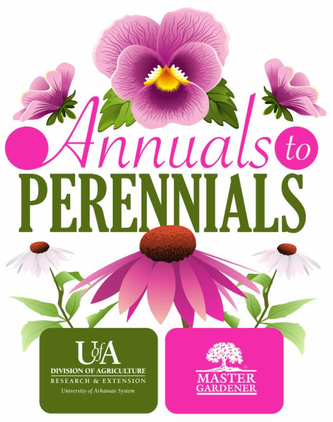|
Ozark Green Thumb BCMG Monthly e-Newsletter |
|
|
|
Programs designed specifically for new MGs and their mentors. Pick one date and learn and enjoy! More information to follow. JUNE 22 - Annuals to Perennials, Hope, AR 26 - Annuals to Perennials, Fayetteville, AR JULY 11 - Annuals to Perennials, Batesville, AR 12 - Annuals to Perennials, Little Rock, AR
0 Comments
FEBRUARY GARDEN CHECKLIST
Baxter County Master Gardener Seminar is on March 21 at the First United Methodist Church Fellowship Center in Mtn. Home. There is a fee of $30 per person to attend the seminar, which includes lunch. Attendance is limited and pre-registration is required. To register mail name, address, phone number, e-mail (if available) and check payable to BCMG to: Kathrine Gilmore, BCMG Seminar, 275 Sharon Dr., Mtn. Home, AR 72653 or go to http://www.baxtercountymg.com/spring-seminar.html . Registration opens on January 2, 2020. Seminar topics and speakers are as follows:
For more information, contact the University of Arkansas Division of Agriculture Cooperative Extension office at 870-425-2335. It may be cold and wintry, but there’s still plenty to be mindful of around the yard and garden. Winter is a great time to fellowship with other gardeners and grow your gardening knowledge!
For more information, contact the University of Arkansas Division of Agriculture Cooperative Extension office at 870-425-2335.  The Baxter County Master Gardeners are a fun group of folks who enjoy sharing their love of gardening with any visitor. At our meetings we have speakers, refreshments, & fun. Come join us! Next Meeting Date: January 9, 2020 1:00 pm - 3:00 pm Meeting Place: The First Presbyterian Church 1106 Spring Street Mountain Home, AR January Speaker: Guest Speaker: Steve Blumreich, President of the Friends of the North Fork & White Rivers Topic: Wonderful, Beautiful, and Mysterious Monarch Butterflies Master Gardeners Monthly Radio Program: Mountain Talk Radio January 15th on 97.1 7:15 a.m. - 8:am. Master Gardener Hosts are Tommy Hagan and Ceil Gasiecki Directions: From Mountain Home Take US Hwy. 62B East through Mountain Home until you come to Cardinal Street. Cardinal Street is the intersection just past Harp's Grocery. Turn right onto Cardinal Street and travel South until you come to the first stop sign which should be Spring Street. Turn left onto Spring Street and go down the hill past the bridge and the First Presbyterian Church will be on your right hand side. From Gassville: Take Hwy. 62/412 towards Mountain Home. Once you get to Mountain Home continue on into Mountain Home on US 62B. This will take you through town till you get to Harp's Grocery and you come to Cardinal Street. Cardinal Street is the intersection just past Harp's Grocery. Turn right onto Cardinal Street and travel South until you come to the first stop sign which should be Spring Street. Turn left onto Spring Street and go down the hill past the bridge and the First Presbyterian Church will be on your right hand side. here to edit. |
Archives
April 2022
|
|

